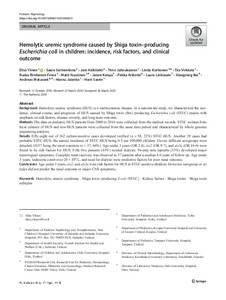Hemolytic uremic syndrome caused by Shiga toxin-producing Escherichia coli in children: incidence, risk factors, and clinical outcome
Elisa Ylinen; Saara Salmenlinna; Jani Halkilahti; Timo Jahnukainen; Linda Korhonen; Tiia Virkkala; Ruska Rimhanen-Finne; Matti Nuutinen; Janne Kataja; Pekka Arikoski; Laura Linkosalo; Xiangning Bai; Andreas Matussek; Hannu Jalanko; Harri Saxén
https://urn.fi/URN:NBN:fi-fe2021042821796
Tiivistelmä
Background Hemolytic uremic syndrome (HUS) is a multisystemic disease. In a nationwide study, we characterized the incidence, clinical course, and prognosis of HUS caused by Shiga toxin (Stx)-producing Escherichia coli (STEC) strains with emphasis on risk factors, disease severity, and long-term outcome.
Methods The data on pediatric HUS patients from 2000 to 2016 were collected from the medical records. STEC isolates from fecal cultures of HUS and non-HUS patients were collected from the same time period and characterized by whole genome sequencing analysis.
Results Fifty-eight out of 262 culture-positive cases developed verified (n = 58, 22%) STEC-HUS. Another 29 cases had probable STEC-HUS, the annual incidence of STEC-HUS being 0.5 per 100,000 children. Eleven different serogroups were detected, O157 being the most common (n = 37, 66%). Age under 3 years (OR 2.4), stx2 (OR 9.7), and stx2a (OR 16.6) were found to be risk factors for HUS. Fifty-five patients (63%) needed dialysis. Twenty-nine patients (33%) developed major neurological symptoms. Complete renal recovery was observed in 57 patients after a median 4.0 years of follow-up. Age under 3 years, leukocyte count over 20 x 10(9)/L, and need for dialysis were predictive factors for poor renal outcome.
Conclusions Age under 3 years, stx2, and stx2a were risk factors for HUS in STEC-positive children. However, serogroup or stx types did not predict the renal outcome or major CNS symptoms.
Kokoelmat
- Rinnakkaistallenteet [27094]
